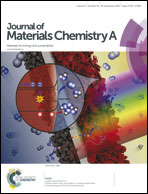A dual-reaction-center Fenton-like process on –C![[triple bond, length as m-dash]](https://www.rsc.org/images/entities/char_e002.gif) N–Cu linkage between copper oxides and defect-containing g-C3N4 for efficient removal of organic pollutants†
N–Cu linkage between copper oxides and defect-containing g-C3N4 for efficient removal of organic pollutants†
Abstract
Copper oxides were supported on the surface of defect-containing g-C3N4 (d-g-C3N4–Cu) by alkalization and hydrothermal methods and characterized using a variety of techniques and density functional theory (DFT) calculations. It was verified that dual reaction centers were constructed by the complexation of–C1![[triple bond, length as m-dash]](https://www.rsc.org/images/entities/char_e002.gif) N1–Cu linkages between Cu of copper oxides (CuOx) and cyano (–C1
N1–Cu linkages between Cu of copper oxides (CuOx) and cyano (–C1![[triple bond, length as m-dash]](https://www.rsc.org/images/entities/char_e002.gif) N1) groups of the side chain in the tri-s-triazine ring of d-g-C3N4, which formed electron-rich centers around Cu sites and electron-poor centers around C1 sites. Based on the experimental results, it was established that the Fenton-like process took place with H2O2 being mainly reduced to hydroxyl radicals (˙OH) by the electrons from electron-rich Cu centers, while both OH− and pollutants were adsorbed on the C1 sites, and could be oxidized to donate electrons to Cu centers by electron transfer of π → Cu in –C1
N1) groups of the side chain in the tri-s-triazine ring of d-g-C3N4, which formed electron-rich centers around Cu sites and electron-poor centers around C1 sites. Based on the experimental results, it was established that the Fenton-like process took place with H2O2 being mainly reduced to hydroxyl radicals (˙OH) by the electrons from electron-rich Cu centers, while both OH− and pollutants were adsorbed on the C1 sites, and could be oxidized to donate electrons to Cu centers by electron transfer of π → Cu in –C1![[triple bond, length as m-dash]](https://www.rsc.org/images/entities/char_e002.gif) N1–Cu, maintaining charge balance on the d-g-C3N4–Cu. Thus, the catalyst was highly efficient for the degradation of various refractory organic pollutants in water of pH from 3 to 10; moreover, higher pH resulted in higher reaction efficiency because more adsorbed OH− at C1 sites produced more ˙OH. Our findings indicate that the dual-reaction-center Fenton-like process is very promising for environmental remediation.
N1–Cu, maintaining charge balance on the d-g-C3N4–Cu. Thus, the catalyst was highly efficient for the degradation of various refractory organic pollutants in water of pH from 3 to 10; moreover, higher pH resulted in higher reaction efficiency because more adsorbed OH− at C1 sites produced more ˙OH. Our findings indicate that the dual-reaction-center Fenton-like process is very promising for environmental remediation.
![Graphical abstract: A dual-reaction-center Fenton-like process on –C [[triple bond, length as m-dash]] N–Cu linkage between copper oxides and defect-containing g-C3N4 for efficient removal of organic pollutants](/en/Image/Get?imageInfo.ImageType=GA&imageInfo.ImageIdentifier.ManuscriptID=C8TA04873H&imageInfo.ImageIdentifier.Year=2018)


 Please wait while we load your content...
Please wait while we load your content...
![[triple bond, length as m-dash]](https://www.rsc.org/images/entities/h2_char_e002.gif) N–Cu linkage between copper oxides and defect-containing g-C3N4 for efficient removal of organic pollutants
N–Cu linkage between copper oxides and defect-containing g-C3N4 for efficient removal of organic pollutants